The Leibniz-IZW is an internationally renowned German research institute. It is part of the Forschungsverbund Berlin e.V. and a member of the Leibniz Association. Our goal is to understand the adaptability of wildlife in the context of global change and to contribute to the enhancement of the survival of viable wildlife populations. For this purpose, we investigate the diversity of life histories, the mechanisms of evolutionary adaptations and their limits, including diseases, as well as the interrelations of wildlife with their environment and people. We use expertise from biology and veterinary medicine in an interdisciplinary approach to conduct fundamental and applied research – from the molecular to the landscape level – in close dialogue with the public and stakeholders. Additionally, we are committed to unique and high-quality services for the scientific community.
+++ Current information on African swine fever: The Leibniz-IZW conducts research on the population dynamics, on models of disease outbreaks in wild boars and on the ecology and human-wildlife interaction in urban areas. African swine fever is a reportable disease in domestic swine and therefor is the purview of the respective federal state laboratories and the Friedrich-Loeffler-Institut (Federal Research Institute for Animal Health) FLI. +++
News
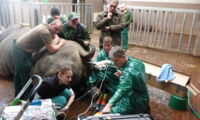
The Northern White Rhino – Advanced Reproductive Technologies Provide a Realistic Chance for Saving the Critically Endangered Species
In early March, Dvůr Králové Zoo, Czech Republic, hosted a meeting of the European Northern White Rhino Working Group. The international experts aim at saving the northern white rhino from the brink of extinction. With the three last individuals incapable of natural breeding, it is the most endangered mammal at present. The meeting in Dvůr Králové proved that collection of eggs, known as ovum pick-up (OPU), from the last two females can be conducted in the foreseeable future. The advanced OPU technique was developed for these large (two tons) creatures in the past two years in the closely related southern white rhino. Gamete collection was combined with advanced in-vitro egg maturation and fertilisation protocols.
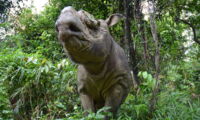
Vaccination stops tumor growth in rhinoceros
Female rhinoceros often suffer from vaginal or uterus tumors, which complicate the production of offspring. For the first time, scientists from the Leibniz Institute for Zoo and Wildlife Research (IZW) in Berlin and the University of Veterinary Medicine in Vienna succeeded in stopping the growth and regeneration of innocuous tumors via vaccination. The treatment was successfully conducted in southern white rhinoceros (Ceratotherium simum simum) and greater one-horned rhinoceros (Rhinoceros unicornis). Injecting the serum “Improvac“ influences the release of sexual hormones, which causes the female oestrous cycle to cease and thereby reduces hormone-dependent tumors. These results have been published in the scientific open access journal PLOS ONE.
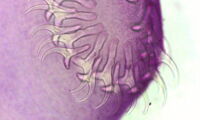
A wolf’s stowaways
Since the year 2000, the Eurasian grey wolf, Canis lupus lupus, has spread across Germany. For Ines Lesniak, doctoral student at the Leibniz Institute for Zoo and Wildlife Research (Leibniz-IZW), and her colleagues, a good reason to have a closer look at the small “occupants” of this returnee and to ask the question whether the number and species of parasites change with an increasing wolf population. This was the case, because the number of parasite species per individual wolf increased as the wolf population expanded. Furthermore, cubs had a higher diversity of parasite species than older animals. The good news: wolf parasites do not pose a threat to human health. The results of this study were published in the scientific online journal “Scientific Reports” of the Nature Publishing Group.
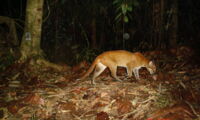
Closely related yet so different - two felid cousins responded in the past very differently to climate change
Southeast Asia is home to numerous felids, including the Asian golden cat and the bay cat. The two cat species are closely related sister species which split from each other 3.16 million years ago. Yet, their more recent history was quite different.
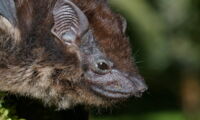
Date-licious smell for bats
Females of the greater sac-winged bat select their mating partner by smell and unerringly choose a male which differs from them the most in genetic terms. Females with more variants of olfactory receptors of the TAAR-group have an advantage over other females. The results of this study have been released by the Nature Publishing Group in their open access journal “Scientific Reports“.
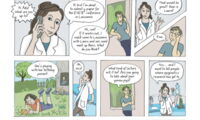
Science comic by the Leibniz-IZW
The Leibniz Institute for Zoo and Wildlife Research (Leibniz-IZW) has translated the results of its research into a comic. It tells a story about wild guinea pigs and teaches us that genes are not everything: environmental conditions and individual experiences can influence which sections of the genetic code are used. The Leibniz-IZW-comic "Epigenetics - bridge between genome and environment" is published by Jaja-Verlag.

Leibniz-IZW receives grant of the Philipp Schwartz Initiative
The Berlin Leibniz Institute for Zoo and Wildlife Research (Leibniz-IZW) support researchers from dangerous regions of the world. Now, the Philipp Schwartz Initiative provided the Leibniz-IZW with an opportunity to award a two years fellowship to a researcher from Syria.
Read more … Leibniz-IZW receives grant of the Philipp Schwartz Initiative
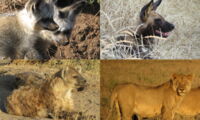
A rare combination of genetic changes increases the virulence of canine distemper virus (CDV) and explains how CDV killed lions and spotted hyenas in the Serengeti
The long-running debate about why just one of several canine distemper virus (CDV) outbreaks in the Serengeti in Tanzania during the past 25 years was fatal for lions and spotted hyenas has been resolved. An international team of scientists, led by researchers at the German Leibniz Institute for Zoo and Wildlife Research (IZW), conducted genetic analyses of CDV strains obtained from a range of carnivores between 1993 and 2012 and discovered that lethal CDV infections in lions and hyenas during the 1993/1994 epidemic was caused by a rare and genetically distinct CDV strain with three rare mutations not present in any other Serengeti strain isolated from domestic dogs or wild canids. Two of these rare mutations were found to increase the ability of CDV to invade lion cells.




